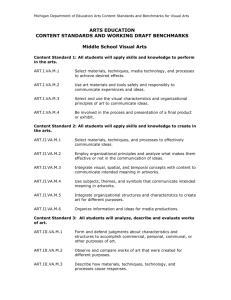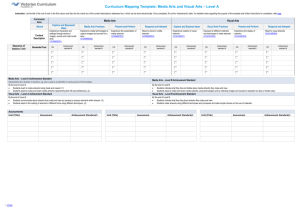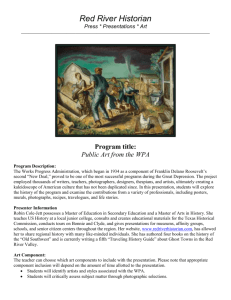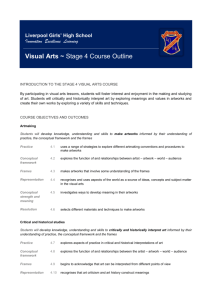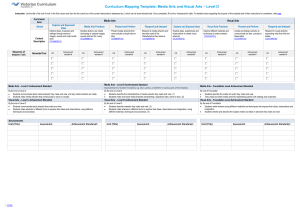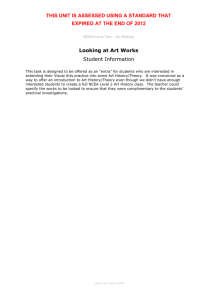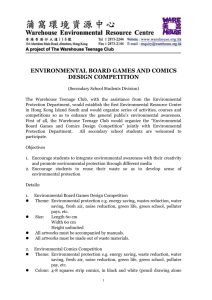Syllabus
advertisement
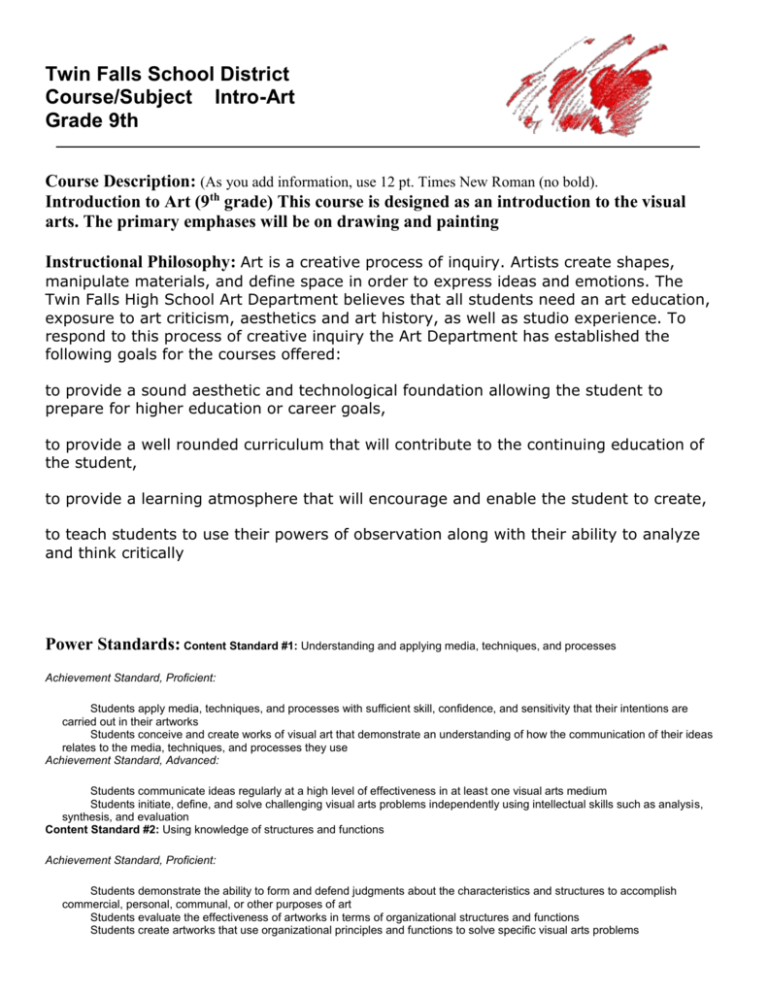
Twin Falls School District Course/Subject Intro-Art Grade 9th Course Description: (As you add information, use 12 pt. Times New Roman (no bold). Introduction to Art (9th grade) This course is designed as an introduction to the visual arts. The primary emphases will be on drawing and painting Instructional Philosophy: Art is a creative process of inquiry. Artists create shapes, manipulate materials, and define space in order to express ideas and emotions. The Twin Falls High School Art Department believes that all students need an art education, exposure to art criticism, aesthetics and art history, as well as studio experience. To respond to this process of creative inquiry the Art Department has established the following goals for the courses offered: to provide a sound aesthetic and technological foundation allowing the student to prepare for higher education or career goals, to provide a well rounded curriculum that will contribute to the continuing education of the student, to provide a learning atmosphere that will encourage and enable the student to create, to teach students to use their powers of observation along with their ability to analyze and think critically Power Standards: Content Standard #1: Understanding and applying media, techniques, and processes Achievement Standard, Proficient: Students apply media, techniques, and processes with sufficient skill, confidence, and sensitivity that their intentions are carried out in their artworks Students conceive and create works of visual art that demonstrate an understanding of how the communication of their ideas relates to the media, techniques, and processes they use Achievement Standard, Advanced: Students communicate ideas regularly at a high level of effectiveness in at least one visual arts medium Students initiate, define, and solve challenging visual arts problems independently using intellectual skills such as analysis, synthesis, and evaluation Content Standard #2: Using knowledge of structures and functions Achievement Standard, Proficient: Students demonstrate the ability to form and defend judgments about the characteristics and structures to accomplish commercial, personal, communal, or other purposes of art Students evaluate the effectiveness of artworks in terms of organizational structures and functions Students create artworks that use organizational principles and functions to solve specific visual arts problems Achievement Standard, Advanced: Students demonstrate the ability to compare two or more perspectives about the use of organizational principles and functions in artwork and to defend personal evaluations of these perspectives Students create multiple solutions to specific visual arts problems that demonstrate competence in producing effective relationships between structural choices and artistic functions Content Standard #3: Choosing and evaluating a range of subject matter, symbols, and ideas Achievement Standard, Proficient: Students reflect on how artworks differ visually, spatially, temporally, and functionally, and describe how these are related to history and culture Students apply subjects, symbols, and ideas in their artworks and use the skills gained to solve problems in daily life Achievement Standard, Advanced: Students describe the origins of specific images and ideas and explain why they are of value in their artwork and in the work of others Students evaluate and defend the validity of sources for content and the manner in which subject matter, symbols, and images are used in the students' works and in significant works by others Content Standard #4: Understanding the visual arts in relation to history and cultures Achievement Standard, Proficient: Students differentiate among a variety of historical and cultural contexts in terms of characteristics and purposes of works of art Students describe the function and explore the meaning of specific art objects within varied cultures, times, and places Students analyze relationships of works of art to one another in terms of history, aesthetics, and culture, justifying conclusions made in the analysis and using such conclusions to inform their own art making Achievement Standard, Advanced: Students analyze and interpret artworks for relationships among form, context, purposes, and critical models, showing understanding of the work of critics, historians, aestheticians, and artists Students analyze common characteristics of visual arts evident across time and among cultural/ethnic groups to formulate analyses, evaluations, and interpretations of meaning Content Standard #5: Reflecting upon and assessing the characteristics and merits of their work and the work of others Achievement Standard, Proficient: Students identify intentions of those creating artworks, explore the implications of various purposes, and justify their analyses of purposes in particular works Students describe meanings of artworks by analyzing how specific works are created and how they relate to historical and cultural contexts Students reflect analytically on various interpretations as a means for understanding and evaluating works of visual art Achievement Standard, Advanced: Students correlate responses to works of visual art with various techniques for communicating meanings, ideas, attitudes, views, and intentions Content Standard #6: Making connections between visual arts and other disciplines Achievement Standard, Proficient: Students compare the materials, technologies, media, and processes of the visual arts with those of other arts disciplines as they are used in creation and types of analysis Students compare characteristics of visual arts within a particular historical period or style with ideas, issues, or themes in the humanities or sciences Achievement Standard, Advanced: Students synthesize the creative and analytical principles and techniques of the visual arts and selected other arts disciplines, the humanities, or the sciences Major Course Projects and Assignments: The major emphases will be drawing in perspective and being able to view proportional items that will be assigned to each student. Each student will be able understanding how to paint in different styles and techniques and be incorporated with art history and cultural diversity. Assessment and Grading Plan: Projects- 100 to 300 points Tests- 100 points Quizzes- 25 points Writing projects- 100 points Grading Scale: Each project will have a number value. 90-100 A, 89-80 B, 79-70 C, 69-60 D, below 60 is a failure grade. Components of the Grade: Each project will be evaluated by how well the student understands, creates, and visualizes the concepts of the principles of art and elements of design. Policy for Re-Doing Work: Any completed assignment that does not meet a proficient level, student will be given the option to fix or redo the assignment. Revised work must be turned in one week after the return date Opportunities for Extra Help: Extra help is available before school and after school. Grading Rubrics: INTRO TO ART PORTFOLIO ASSESSMENT IDEAS AND DESIGN THE INTEGRITY OF ANY WORK OF ART IS DEPENDENT ON THE INITIAL IDEA. THE IDEA IS BEST THOUGHT OUT THROUGH PRELIMINARY SKETCHES AND EXPERIMENTATION. EACH WORK OF ART ADDRESSES A RANGE OF TECHNIQUES OR ISSUES AND SHOULD STRIVE FOR EXCELLENT TECHNICAL QUALITY. CRAFTSMANSHIP AND TECHNIQUE THE ABILTIY TO HANDLE A MEDIA IS APPARENT TO THE EYE. CAREFUL ATTENTION AND STUDY OF THE MEDIA WILL DEVELOP SKILL AND FINE CRAFTSMANSHIP. TECHNIQUE IN FORMING THE WORK WILL DETERMINE ITS INTEGRITY. ATTENDANCE AND ATTITUDE THE TIME AND ENERGY PUT INTO A WORK OF ART IS DIRECTLY REFLECTED IN THE FINAL RESULT. ADEQUATE CLASS TIME IS GIVEN TO COMPLETE EACH PROJECT. TIME SHOULD BE PACED TO INSURE THAT CAREFUL HANDLING OF THE PROJECT WILL RESULT IN AN AESTHETICALLY PLEASING PRODUCT. THE FOLLOWING ASPECTS WILL BE CONSIDERED WHEN YOUR PORTFOLIO IS REVIEWED. NUMBER OF PROJECTS IN THE PORTFOLIO AS ASSIGNED. CLEAN AND NEATLY ARRANGED FORMAT DEMONSTRATION OF CONCEPTS AND TECHNIQUES OVERALL EFFORT AND QUALITY OF THE WORK CREATIVE THINKING AND PROBLEM SOLVING ABILITY QUALITY RATINGS EXCELLENT QUALITY -- ADVANCED WORK AT THIS LEVEL IS CONSISTENTLY OF HIGH QUALITY, ALTHOUGH NOT ALL PIECES WILL NECESSARILY BE AT PRECISELY THE SAME LEVEL OF EXPERTISE. WORK SHOWS OBVIOUS EVIDENCE OF THINKING. IT MAY ADDRESS FAIRLY COMPLEX VISUAL AND/OR CONCEPTUAL IDEAS. IT HAS SOME SENSE OF INVENTIVENESS/IMAGINATION. MATERIALS ARE USED WELL -- TECHNIQUE IS GENERALLY EXCELLENT. IT MAY SHOW A GENERALLY SUCCESSFUL ENGAGEMENT WITH EXPERIMENTATION AND/OR RISK-TAKING. THE WORK MAY BE NOTABLE OF SENSITIVITY AND/OR SUBTLETY. COMPOSITION IS PURPOSEFUL. THERE IS STRONG EVIDENCE OF AWARENESS OF STYLE AND FORMAT – A SENSE OF INFORMED DECISION-MAKING. STRONG QUALITY – PROFICIENT WORK AT THIS LEVEL IS GENERALLY STRONG, ALTHOUGH THERE MAY BE INCONSISTENCIES IN THE OVERALL QUALITY. WORK SHOWS EVIDENCE OF THINKING; i.e., IT CONVEYS A SENSE THAT IT IS ABOUT SOMETHING. IT IS FAIRLY CONFIDENT. IT MAY HAVE SOME EVOCATIVE QUALITIES. THERE IS SUCCESSFUL ENGAGEMENT WITH MOST ASPECTS OF TECHNIQUE AND MATERIALS. COMPOSITION IS GENERALLY STRONG. GOOD QUALITY – NOVICE WORK SHOWS A SENSE OF REAL EFFORT AND SOME SENSE OF DIRECTION/PURPOSE BUT PROBLEMS ARE NOT ALWAYS SUCCESSFULLY RESOLVED. IT MAY BE MORE ACCOMPLISHED TECHNICALLY THAN IT IS CONCEPTUALLY SOME MANIPULATION OF IDEAS IS EVIDENT TECHNIQUE MAY BE ERRATIC, WITH LITTLE OR NO SENSE OF CHALLENGE THE WORK MAY BE MORE AMBITIOUS THAN WORK THAT RECIEVES A SCORE OF 2 WITHOUT NECESSARILY BEING MORE SUCCESSFUL. WEAK QUALITY – ATTEMPT TECHNICAL ASPECTS ARE WEAK SOLUTIONS TO PROBLEMS SEEM TO BE SIMPLISTIC THE SENSE OF EXPLORATION OF THE MEDIUM IS MISSING. ATTEMPTS TO DEAL WITH IDEAS OR TECHNICAL PROBLEMS ARE NOT REALIZED. WORK MAY BE UNEVEN. DRAWING SEEMS TO BE AWKWARD. COMPOSITION IS WEAK IN CONTRAST TO WORK THAT RECEIVES A SCORE OF 1, THERE IS AT LEAST SOME SENSE OF ARTISTIC DECISION-MAKING. POOR QUALITY – LACKING THERE IS LITTLE, IF ANY EVIDENCE OF THINKING. TECHNIQUE IS POOR. WORK SHOWS A LACK OF AWARENESS OF TOOLS/MEDIA. SOLUTIONS TEND TO BE TRITE. COMPOSITION IS POOR, OR DOESN’T APPEAR TO HAVE BEEN CONSIDERED. NO ATTEMPT MADE
